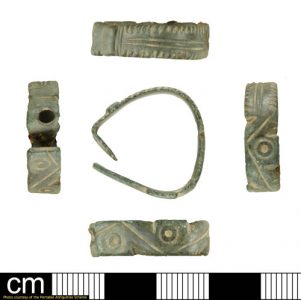FINGER RING 984816
Description: A short section of a Roman copper alloy bracelet that has been bent into a finger ring dating to c. AD 320 to 450.
The artefact is formed of a strip of copper alloy. The strip is sub-rectangular in cross section with a slightly rounded edges. This strip has been bent into now almost triangular hoop with rounded corners. One end of the strip ends in a transverse, patinated cut. The other appears to be the original end of the bracelet with a slight constriction followed by a slightly expanded oval terminal which extends into a point at its outer edge, This terminal has slightly off centre circular hole through it.
The outer surface of the bracelet is decorated along its length with different zones of incised and stamped decoration. The terminal is plain apart from small, regularly spaced incised lines running in short distances towards the centre from the outer edge. There is a raised oval across the entire width of the constricted area followed by three incised transverse lines. Then is a section about a third on the remaining length which has similar closely spaced incised lines running in from each edge to about one sixth of the width of the bracelet on each side; these flank a pair of incised lines running down the centre of the band. This section ends in a short plain area. The remainder of the band is decorated with a long incised diagonal line zig zagging along the band. In each triangle formed by this line is a stamped ring with central circular dot flanked by deep triangular notches which run in from the edge to a third of the width of the band.
The band of the bracelet is 6.4mm wide and 1.4mm thick. The hoop is 22.5mm long by 20.7mm wide. It weighs 3.44g.
The fragment can be compared to other bracelets with mixed motif decoration published by Crummy (1983: 46, fig. 47, particularly No.1731 and 1732). Some of these were unstratified, however, the majority were found in graves in Colchester daring from c.AD 320-450 (Crummy 1983,3). Similar examples are also illustrated by Swift (2000:154, Fig 192) who also shows that these bracelets were well distributed across the south of Britain. The bracelet has clearly been shortened and then bent to be re-used as a finger ring. Similar finger rings can be seen illustrated by Crummy (1983, 48, particularly No. 1774) and have been studied by Swift (2012,1, 6) who suggests this is a later fourth to early fifth century phenomenon.
Date: 320 - 450
Object type: FINGER RING
Last import: September 22, 2022


